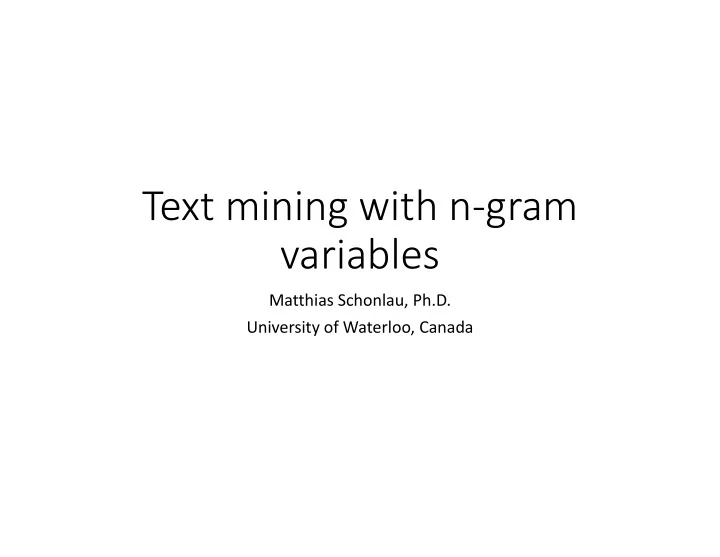

Text mining with n‐gram variables Matthias Schonlau, Ph.D. University of Waterloo, Canada
What to do with text data? • The most common approach to dealing with text data is as follows: • Step 1: encode text data into numeric variables • n‐gram variables • Step 2: analysis • E.g. Supervised learning on n‐gram variables • E.g. Topic modeling (clustering) (*) Another common approach is to run neural network models (deep learning). This gives higher accuracy for large data sets. It is also far more complicated.
Overview • n‐gram variables approach to text mining • Example 1: Immigrant Data (German) • Example 2: Patient Joe (Dutch)
Text mining: “bag of words” • Consider each distinct word to be a feature (variable) • Consider the text “The cat chased the mouse” • 4 distinct features (words) • Each word occurs once except “the” which occurs twice
Unigram variables . input strL text • Single‐word variables text are called unigrams 1. "The cat chased the mouse" • Can use frequency 2. "The dog chases the bone" (counts) or indicators 3. end; (0/1) . set locale_functions en . ngram text, threshold(1) stopwords(.) . list t_* n_token +--------------------------------------------------------------------------+ | t_bone t_cat t_chased t_chases t_dog t_mouse t_the n_token | |--------------------------------------------------------------------------| 1. | 0 1 1 0 0 1 2 5 | 2. | 1 0 0 1 1 0 2 5 | +--------------------------------------------------------------------------+
Unigram variables • Threshold is the minimum . ngram text, threshold(2) stopwords(.) number of observations in which the word has to occur . list t_* n_token before a variable is created. +-----------------+ • Threshold(2) means that all | t_the n_token | |-----------------| unigrams occurring only in 1. | 2 5 | one observation are 2. | 2 5 | dropped +-----------------+ • This is useful to limit the number of variables being created
Removing stopwords . set locale_functions en • Remove common . ngram text, threshold(1) words “stopwords” Removing stopwords specified in stopwords_en.txt unlikely to add . list t_* n_token meaning e.g. “the” • There is a default list +------------------------------------------------------------------+ | t_bone t_cat t_chased t_chases t_dog t_mouse n_token | of stopwords |------------------------------------------------------------------| • The stopword list 1. | 0 1 1 0 0 1 5 | can be customized 2. | 1 0 0 1 1 0 5 | +------------------------------------------------------------------+
Stemming • “chased” and “chases” have the same meaning but are coded as different variables. • Stemming is an attempt to reduce a word to its root by cutting off the end • E.g. “chased” and “chases” turns to “chase” • This often works well but not always • E.g. “went” does not turn into “go” • The most popular stemming algorithm, the Porter stemmer, is implemented
Stemming . set locale_functions en . ngram text, threshold(1) stemmer Removing stopwords specified in stopwords_en.txt stemming in 'en' . list t_* n_token +-----------------------------------------------------+ | t_bone t_cat t_chase t_dog t_mous n_token | |-----------------------------------------------------| 1. | 0 1 1 0 1 5 | 2. | 1 0 1 1 0 5 | +-----------------------------------------------------+
“Bag of words” ignores word order . input strL text text 1. "The cat chased the mouse" 2. "The mouse chases the cat" 3. end; • Both sentences have . set locale_functions en . ngram text, threshold(1) stemmer degree(1) the same encoding! Removing stopwords specified in stopwords_en.txt stemming in 'en' . list t_* n_token +------------------------------------+ | t_cat t_chase t_mous n_token | |------------------------------------| 1. | 1 1 1 5 | 2. | 1 1 1 5 | +------------------------------------+
Add Bigrams . ngram text, threshold(1) stemmer degree(2) • Bigrams are two‐word Removing stopwords specified in sequences stopwords_en.txt stemming in 'en' • Bigrams partially recover word order . list t_chase_mous t_mous_chase • But … +---------------------+ | t_chas~s t_mous~e | |---------------------| 1. | 1 0 | 2. | 0 1 | +---------------------+
Add Bigrams • … but the number of variables grows rapidly . describe simple text t_mous t_cat_ETX t_chase_mous n_token t_cat t_STX_cat t_cat_chase t_mous_ETX t_chase t_STX_mous t_chase_cat t_mous_chase Special bigrams: STX_cat : “cat” at the start of the text (after removing stopwords) cat_ETX: “cat” at the end of the text (after removing stopwords)
input strL text "I say Corona, you say Covid" Corona example "Find a vaccine, please!" "No vaccines. All is challenging. CHALLENGE!" "Will Corona beer change its name?" "Home schooling is a challenge." end; set locale_function en // default on “English” computers ngram text , threshold(2) stem prefix(_) list , abbrev(10) . list , abbrev(10) +---------------------------------------------------------------------------------------+ | text _challeng _corona _vaccin n_token | |---------------------------------------------------------------------------------------| 1. | I say Corona, you say Covid 0 1 0 6 | 2. | Find a vaccine, please! 0 0 1 4 | 3. | No vaccines. All is challenging. CHALLENGE! 2 0 1 6 | 4. | Will Corona beer change its name? 0 1 0 6 | 5. | Home schooling is a challenge. 1 0 0 5 | +---------------------------------------------------------------------------------------+
n‐gram variables works • While easy to make fun of the n‐gram variable approach works quite well on moderate size texts • Does not work as well on long texts (e.g. essays, books) because there is too much overlap in words.
Spanish . input strL text text 1. "Dad crédito a las obras y no a las palabras." • Don Quijote de la 2. end; Mancha . • “Give credit to the . set locale_functions es actions and not to . ngram text, threshold(1) stemmer the words “ Removing stopwords specified in stopwords_es.txt stemming in 'es' . list t_* n_token +-------------------------------------------------+ | t_crédit t_dad t_obras t_palabr n_token | |-------------------------------------------------| 1. | 1 1 1 1 10 | +-------------------------------------------------+
Recommend
More recommend